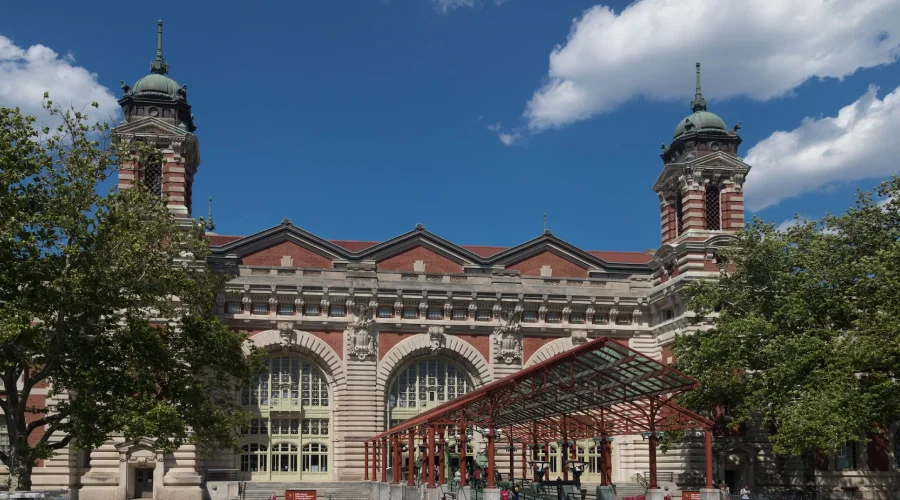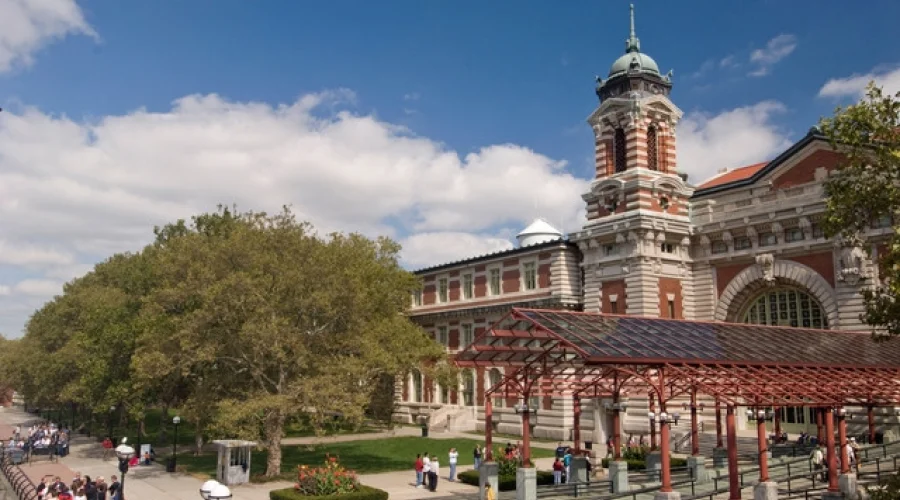Ellis Island

About the Ellis Island
The Upper New York Bay’s Ellis Island has a special position in American history as the emblem of immigration. The Ellis Island National Museum of Immigration is a component of the Statue of Liberty National Monument. This island, which covers approximately 27.5 acres, served as the primary immigration processing station for the United States from 1892 to 1954.
Ellis Island serves as a symbol of the continuing spirit of opportunity and optimism that has shaped the United States. It continues to represent the American identity and acts as a reminder of the many different cultures and backgrounds that go into creating the American identity.

History of the Ellis Island
Ellis Island history spans several centuries, from its earliest use by Native Americans to its role as a gateway for immigrants to the United States. Before European settlers arrived, the island was inhabited by the Lenape people, who named it “Kioshk” or Gull Island. In the 17th century, it was part of the territory controlled by the Dutch West India Company. In the early 19th century, the federal government recognized the strategic importance of the island and purchased it. Fort Gibson, a defensive fort, was constructed during this time.
The most significant chapter in Ellis Island’s history began in 1892 when the federal government opened an immigrant processing station there. It was initially a wooden structure, but in 1897, a fire destroyed most of the buildings. The main building that stands today was completed in 1900, designed to accommodate the massive influx of immigrants arriving in New York.
Ellis Island ceased its role as an immigrant processing center in 1954. Afterward, it was used as a detention center for various purposes, including housing Cuban refugees in the 1980s. In 1990, Ellis Island underwent significant restoration, and the Ellis Island National Museum of Immigration was opened in 1992. Today, this museum serves as a tribute to the immigrant experience, showcasing artifacts, photographs, and personal stories of those who passed through its gates.
The Island
The port of New York City is home to Ellis Island, a little island in Upper New York Bay. It belongs to the borough of Manhattan and is positioned just south of Manhattan’s southern tip. In comparison to other islands in the bay, the island is tiny, with a total area of around 27.5 acres.
The island is dominated by the historic Main Building, which served as the primary immigrant processing center during the peak years of Ellis Island immigration. This grand Beaux-Arts-style structure is a prominent feature of the island’s landscape and has been meticulously restored to its former glory. Surrounding the Main Building are the remnants of other structures that were once part of the immigrant processing complex, including the hospital buildings and dormitories.
Visitors to Ellis Island arrive by ferry, typically departing from Battery Park in Manhattan. A remarkable feature of the trip is the ferry access to Ellis Island, which provides breathtaking views of the Statue of Liberty and the Manhattan cityscape.
Ellis Island’s hours vary by season. In peak tourist times (spring to fall), it’s open seven days a week. Off-peak (late fall to winter) may have reduced hours or closures on certain days. Check the official Ellis Island website or contact the National Park Service for accurate, up-to-date information.
Ellis Island is now a place of meditation and remembrance in addition to historical importance. With displays that recount the tales of the millions who walked through its gates in quest of a better life, the Ellis Island National Museum of Immigration offers a comprehensive look at the immigrant experience in the United States.

Tips for your visit
- Book Tickets Early: Reserve Ellis Island ferry tickets in advance, especially if you want to visit the museum and Statue of Liberty. Consider a combination ticket.
- Hours and Closures: Check Ellis Island hours and any closures or special events before your visit, as they can vary by season.
- Arrive Early: Get to Battery Park well before your Ellis Island ferry departure time, as lines can be long, and security checks can take time.
- Pack Essentials: Bring comfortable shoes for walking, weather-appropriate clothing, and snacks, as food options are limited on the island.
- Guided Tours: Consider taking a guided Ellis Island tour for deeper insights into its history and significance.
- Ferry Access to Ellis Island: Take the Ellis Island ferry from Battery Park or Liberty State Park. Book tickets in advance, which often include stops at the Statue of Liberty. Check carefully.
- Museum Exploration: Visit the Ellis Island National Museum of Immigration to see artifacts and learn about the immigrant experience.
- Maps and Tours: Grab an Ellis Island map to navigate the island efficiently. Guided and self-guided tours are available.
- Respect the Exhibits: Be respectful when viewing Ellis Island records and artifacts, as they represent the stories of real people.

How to arrive
Ellis Island is accessible only by a ferry ride from designated departure points. There are two main departure points for the Ellis Island ferry: Battery Park in Manhattan and Liberty State Park in New Jersey. Select the one that’s most convenient for you. Buy your Ellis Island ferry tickets in advance online, especially during busy seasons, to avoid long lines and ensure availability. Plan to arrive at the departure point at least 30-45 minutes before your scheduled ferry departure time. This allows time for security checks and boarding.
Getting to Battery Park (Manhattan):
– Subway: Battery Park is easily accessible by subway. Take lines 4 or 5 to Bowling Green, or lines 1, R, or W to South Ferry.
– Bus: Several bus routes, including M5, M15, and M20, stop near Battery Park.
– Taxi/Rideshare: You can also take a taxi or rideshare service to Battery Park. Simply provide the address “Battery Park, New York, NY 10004.”
Getting to Liberty State Park (New Jersey):
– Train: You can take the NJ Transit train to Liberty State Park Station.
– Car: If you’re driving, there’s ample parking available at Liberty State Park.
Be prepared for a security check similar to airport procedures. Make sure to have valid identification with you. Once you’ve cleared security, follow the instructions to board the ferry. Ferries typically run regularly throughout the day, so you can return to your departure point when you’re ready.








